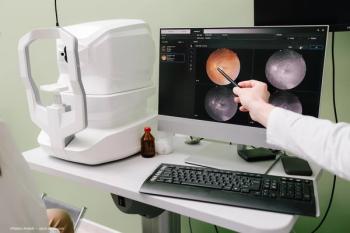
Learn how to recognize, manage bleb leaks
Surgeon outlines potential remedies such as medical therapy, tamponade, adhesives
"It isn't a straightforward problem to deal with, since the fact that so many techniques have been proposed for handling bleb leak indicates that none of them works as well as could be hoped," said Dr. Tsai, associate professor of ophthalmology and director of the glaucoma division at the Edward S. Harkness Eye Institute, Columbia University College of Physicians and Surgeons, New York. "Nevertheless, most of our patients can be helped by one treatment or another."
Dr. Tsai was the first speaker in a session on prevention of complications in glaucoma surgery. He spoke on management of filtration bleb leak.
"Often you'll see a minimal or low filtration bleb," Dr. Tsai said. "You may even observe ocular hypotony associated with corneal folds."
If a Seidel test result is not overtly positive, "I try at least to massage and elevate the bleb, because if there is a low bleb present initially, one may not be able to see a positive Seidel test," he said. "If one pushes on and massages the eye and gets bleb elevation, the Seidel test is often intermittently positive."
A common sign of bleb leak is a shallow anterior chamber, Dr. Tsai said. Other signs and ocular sequelae include optic disc swelling, edema, retinal folds, blebitis, cataract, and choroidal detachments. One of the most feared complications is the late-onset bleb leak associated with diffusely avascular and thin conjunctival tissues, which is often seen in filtration blebs exposed to antimetabolites [i.e., mitomycin-C (Mutamycin), 5-fluorouracil (Adrucil)].
"On histologic study, what has been observed is almost full-thickness epithelial and stromal damage, and often these patients will develop bleb leaks with minimal ocular trauma," Dr. Tsai said.
He will sometimes ask patients who develop recurrent bleb leak, to wear eye shields when they sleep, because they may sleep with their faces against the pillow.
Moreover, a surgical revision procedure in a patient with a large, leaking, avascular filtration bleb may be quite difficult to perform. In these cases, simple advancement of the conjunctival tissues may prove challenging, even if a posterior relaxing incision is made.
Medical therapyInitial treatment should be directed medically, Dr. Tsai said. He will start by reducing the dose of corticosteroids to promote a healing response, and consider using aqueous suppressant therapy to reduce aqueous inflow to the bleb site.
"I will also use topical antibiotics, including the newer fluoroquinolones in combination with older antibiotics like gentamicin (Garamycin), which may be more irritating to the conjunctiva and more likely to induce some fibrosis," he said. "In late bleb leaks, I have had mixed success with trichloroacetic acid (Tri-Chlor)."
Dr. Tsai often couples these pharmacologic measures with ocular tamponade, "either pressure patching in the early postoper- ative period or a large-diameter bandage soft contact lens or collagen shield."
Use of the Simmons shell is decreasing, he said, because of the discomfort it causes for many patients.
Newsletter
Don’t miss out—get Ophthalmology Times updates on the latest clinical advancements and expert interviews, straight to your inbox.













































